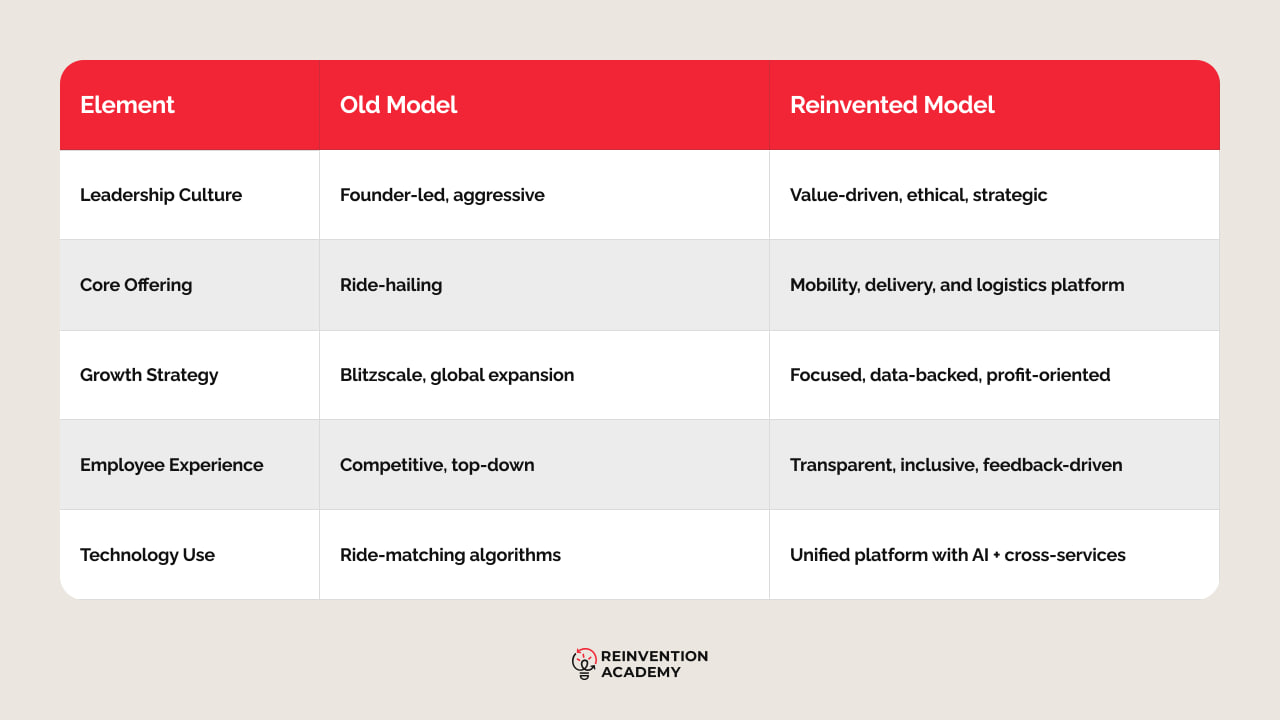How Uber Reinvented Itself: From Chaos to a Global Mobility Platform
Explore how General Motors overcame the crisis through rethinking, ecosystem thinking, and cultural transformation.

Uber, one of the brightest success stories of the digital age, was on the brink of crisis by 2017. The company, which had revolutionized the transportation industry, faced the need to restructure its business model and corporate culture fundamentally. The Uber case study can serve as a clear example of how to cope with the challenges and become a global mobile platform.
Why Uber Needed Reinvention
Uber's initial success was built on radical methods:
- Expansion at all costs: the company entered new markets, often ignoring local legislation
- Price war: Uber's losses reached $4.5 billion in 2017
- "Buying up" competitors: the strategy of absorbing local players with subsequent price increases
- This approach led to impressive results; the company's valuation reached an impressive $68 billion in 2016, but it proved unsustainable.
However, by 2017, Uber's business strategy showed complete unsustainability. The company faced a series of high-profile scandals: revelations about toxic corporate culture and sexism, more than 200 lawsuits in the US alone, and a mass exodus of top managers, with more than 20 key executives in one year. This culminated in the #DeleteUber boycott, which resulted in 500,000 users deleting the app.
This situation was a classic example of Titanic Syndrome, where early successes blinded management to the growing problems. For too long, Uber ignored warnings about cultural issues, blindly believed in the cult of hyper-growth, and lost touch with the real needs of customers and drivers. As subsequent events showed, the company needed a course correction and a profound transformation of its entire business model and corporate values, which eventually happened in the following years.
Uber’s Reinvention Blueprint: Platform, Culture, Profit
The crisis of 2017 forced the company to rethink its strategy completely. Instead of aggressive but unprofitable growth, the company set a course for sustainable development, transforming from a simple cab service to a multifunctional mobility platform. This Uber reinvention touched three key areas: service diversification, cultural transformation, and financial discipline.
1. Platform Diversification
Uber's business model shift focused solely on transportation by creating an ecosystem of interconnected services. The launch of Uber Eats in 2014 initially seemed like a side project, but by 2023, it was generating $11 billion in annual revenue for the company. Further expansion into logistics (Uber Freight) and integration with public transportation in the app allowed it to reach new categories of users. An important step was the Uber One subscription, which combined the benefits of different services and increased customer loyalty. By 2023, more than 12 million people were using it.
2. Cultural Reset Under New Leadership
Uber CEO's leadership change in 2017 was a turning point. The company's new head, Dara Khosrowshahi, emphasized transparency and corporate responsibility. The company introduced strict safety regulations, including driver checks and emergency assistance systems, which reduced incidents by 38%. Focusing on diversity and inclusiveness helped rebuild its reputation: while in 2017 only 22% of leadership positions were held by women, by 2023 the proportion had risen to 39%.
3. Profit-Driven Strategy and Efficiency
Uber has abandoned its "growth at any cost" strategy. Since 2019, the company has curtailed operations in 16 countries, including China and Russia, where competition made the business unprofitable. Optimizing logistics and implementing dynamic pricing reduced operating costs by $1.5 billion annually. For the first time since its founding, Uber went into profit in 2023, earning $1.1 billion in net income, proving that even the most ambitious startups must become financially sustainable sooner or later.
This three-pronged approach, diversification, cultural change, and financial discipline, has transformed Uber from a troubled startup to a mature technology company. However, the main lesson of this transformation is that even the most radical business models must find a balance between innovation and sustainability sooner or later.
Two Enablers That Made Reinvention Stick
These transformations enabled Uber to improve its performance temporarily and anchor the new business model in the long term.
1. Leadership Transformation
The arrival of new leadership led by Dara Khosrowshahi in 2017 marked a turning point in the company's history. Uber trust and ethics rebuild. A major overhaul of the corporate value system was undertaken, where safety, transparency, and inclusiveness came to the forefront. The Board of Directors actively participated in this process, renewing 80% of its membership in two years. Particular attention was paid to creating a balanced management system, with new positions responsible for compliance and ethical standards. These changes increased Uber's investor confidence index from 32% in 2017 to 78% in 2023.
2. Tech Integration Across Divisions
Uber transformed a platform, creating a unified ecosystem for all services, from transportation to food delivery. The company optimized logistics thanks to artificial intelligence and machine learning, reducing the average car pickup time by 25% in major cities. The cross-service analytics system allows for forecasting demand with an accuracy of up to 90%, and it dynamically reallocates resources between different business areas. Special attention was paid to the development of real-time systems; now 85% of calls to the support service are processed automatically with the help of AI, while user satisfaction with the quality of service has increased by 40 points compared to 2018.
These systemic changes in management and technology have created a solid foundation for Uber's new era. The company demonstrates that even after rapid but chaotic growth, building a sustainable and socially responsible business model is possible without losing its innovative potential. As Uber's example shows, true transformation requires not cosmetic changes, but a rethinking of the foundations of how a company creates value for everyone, from drivers and customers to investors and society.
Dr. Nadya Zhexembayeva’s Reinvention Lens on Uber
As organizational change expert Nadya Zhembaeva notes, true reinvention in tech startups requires a fundamental revision of corporate identity, which is the company's path in recent years.
Uber has had to undergo four key metamorphoses:
1. Abandoning the image of a "technology disruptor"
The company consciously moved away from the scandalous image of a "startup aggressor" who ignored rules and social norms. Instead, it created a new image of a responsible partner in urban infrastructure. This transition is confirmed by the changing tone of media coverage: while in 2017, 78% of Uber's media mentions were negative, by 2023, this figure had dropped to 32%.
2. Harmonization of internal culture with external expectations
Uber's cultural transformation has proven to be very significant. A three-step driver vetting system was implemented, and spending on safety programs has increased 250% since 2018 (Uber annual report). As a result, the driver satisfaction index increased from 67 to 89 points in five years.
3. Systematic implementation of changes at all levels
Transformation affected all aspects of operations - from HR policy to technological architecture. Special attention was paid to middle management: 90% of managers were retrained on new leadership standards.
4. Transition from hyper-growth to sustainable value
The company revised its key performance indicators, shifting its focus from gross revenue to unit economics. This enabled the company to reach profitability for the first time in 2023, while the number of trips grew.
As Dr. Zhemembayeva accurately points out in her analysis, "Uber has demonstrated that digital transformation is first and foremost a transformation of human consciousness, and then of technology. The company didn't just change its business model - it redefined its role in the economy, transforming from "aggressive disruptor" to "infrastructure partner," ultimately ensuring its sustainable future.
5 Reinvention Lessons from Uber for Business Leaders
Uber's story contains valuable strategic lessons for companies facing deep transformation. Here are five key principles that helped the company survive and create a sustainable business model.
1. A toxic culture can kill even the best product
Uber has proven firsthand that technological superiority is worthless without a healthy corporate culture. In 2017, the company was on the verge of collapse not because of a bad product, but because of systemic management problems. Gallup research has shown that companies with toxic cultures lose up to 60% of employee productivity. It took Uber years and a change of 80% of top management to fix the situation.
2. Transformation requires a bold change in leadership
The arrival of new CEO Dar Khosrowshahi in 2017 was a watershed moment. His Uber profitability strategy was built on three principles: abandoning unprofitable markets (exiting 16 countries), focusing on unit economics, and investing in sustainable services.
3. Diversification only works if core expertise is retained
Uber smartly expanded its delivery and mobility platform, adding Uber Eats, Uber Freight, and integration with public transportation. However, all new services utilized the company's core competencies: its technology platform and logistics algorithms.
4. Technology without trust does not scale
Uber’s early growth showed that innovation alone isn’t enough without trust; even the most disruptive technology falters. The company had to rebuild credibility by prioritizing safety, transparency, and accountability, proving that sustainable scale comes only when customers and partners feel secure in the system.
5. Reinvention is not a pivot, but a realignment
Uber didn't just course-correct; it completely overhauled its corporate values, rebuilt its technology architecture, and changed its business model
Uber Reinvention at a Glance

Final Destination: Why Uber’s Reinvention Still Moves Forward
How Uber reinvented itself is not just a story of recovery but a demonstration of a fundamental principle of modern business: growth without purpose is fragile. The company that once epitomized the "move fast and break" culture has undergone a profound transformation, proving that sustained success requires courage, humility, and a constant drive to improve.
Uber today is no longer just a cab-hailing app. It is an example of systemic reinvention. Today, the company demonstrates a new type of corporate maturity, where technology serves people and profitability goes hand in hand with social responsibility. This experience is especially valuable in an era where businesses constantly have to rethink their role in a rapidly changing world. As Uber shows, true transformation is not a one-off event but an ongoing process of finding the balance between innovation and sustainability, ambition and ethics, and technological progress and human values.


.svg)